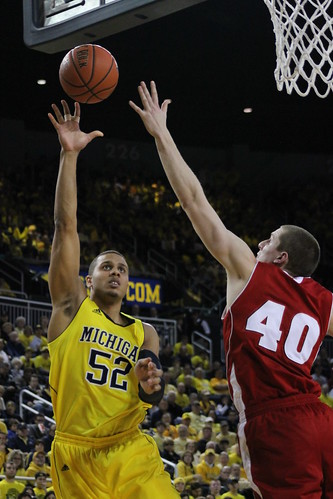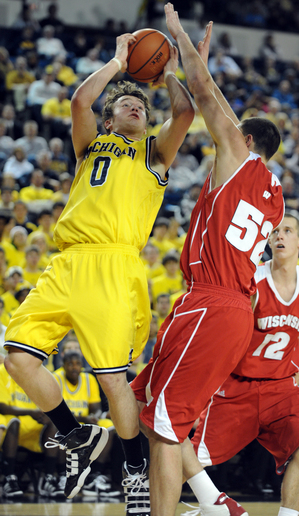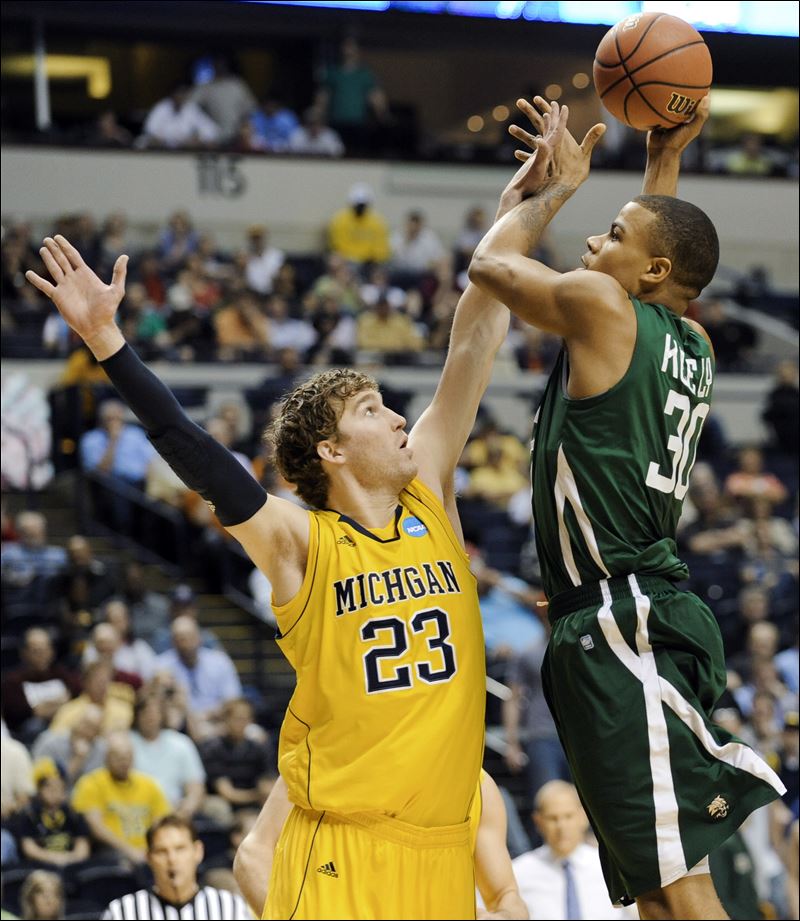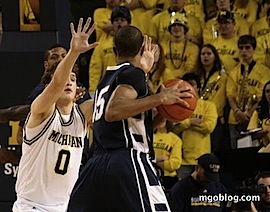colton christian

From our very own Zack Novak photoshop thread.
This is part two of the hoops season recap; part one, covering the guards, can be found here.
It should not come as a surprise to those who have followed John Beilein's Michigan squads that a post covering the team's "bigs" would feature a photo of 6'4" Zack Novak at the top of the post. Michigan entered the season relatively thin in the frontcourt, and things only got worse when backup center Jon Horford suffered a stress fracture in his right foot in December, an injury that would ultimately sideline him for the remainder of the season. When Evan Smotrycz suffered through a brutal slump to start conference play, Novak found himself starting at power forward, reprising his role from years past instead of playing his natural two-guard position.
While Michigan got solid seasons out of Novak and Jordan Morgan, along with some inspired efforts from Smotrycz, the lack of size up front was the team's greatest weakness. This was exposed each time Michigan played Ohio State or Michigan State, especially away from Crisler, and even when all of the bigs got in foul trouble at Northwestern and Colton Christian played important minutes at center. This shouldn't be as much of an issue next season with the addition of Mitch McGary and the return of Horford, but Smotrycz's departure hurts. Let's look back on each player's individual contributions:
 Jordan Morgan
Jordan Morgan
Preseason Expectations: Morgan entered the season as the returning starter after a surprising redshirt freshman season, but he still had to hold off Jon Horford to keep the job. The hope was that he'd develop his post game while continuing to play solid defense, rebound, and hit his fair share of high-percentage shots.
Postseason Reality: Morgan still hasn't displayed much in the way of a back-to-the-basket game, and he missed a maddeningly large amount of layups. The latter point was a source of great frustration, along with his propensity for early foul trouble, but overall Morgan was quite solid in the middle. His defense improved—including a sharp decline in foul rate—his rebounding was solid, and he shot just a hair under 62% from the field. Trey Burke didn't look to Morgan as much as Darius Morris did last year, and there was a clear adjustment period while he got used to playing with a different style of point guard. While there wasn't a big leap forward in Morgan's offensive game, as many had hoped, he did not regress, either. Meanwhile, he was in better shape, running the floor well and consistently posting strong defensive performances. Morgan probably isn't ever going to be an offensive force, nor a intimidating shot-blocker—the touch and explosive athleticism just aren't there—but he's a solid presence who should end up as a four-year starter.
Highlight: The Ohio State win was the most memorable of the season, and it was also the best game of Morgan's career, as he posted his first double-double—11 points (5-8 from the field) and 11 rebounds—while limiting Jared Sullinger to 14 points on 6-14 shooting. Morgan also beat Sullinger down the court for a pair of thunderous dunks in transition.
Lowlight: When Michigan matched up against Ohio State in the conference tournament, things didn't go so well. The Buckeyes dominated the Wolverines inside, and Morgan could only muster three points (1-5 shooting) and four rebounds while turning the ball over three times.
Key Numbers: 61.9 2pt%, 17.8 DR%, 3.9 fouls committed/40 minutes
Next year: Morgan should start at center once again, and it would be nice to see him break out a go-to post move. Mostly, however, Michigan will need him as a rebounder/defender/screen-setter, which falls right into his comfort zone. Also, make layups, please.
 Zack Novak
Zack Novak
Preseason Expectations: Novak was expected to make a grand return to shooting guard, where the hope was that is offensive production would rise now that he no longer had to guard players a half-foot taller while shouldering a large part of the rebounding load.
Postseason Reality: Novak, of course, had to slide back to power forward when Smotrycz was benched early in Big Ten play, and for the fourth straight year his play improved despite not being the focal point of the team. He shot very well from the field—56% on twos, 41% on threes—and posted the team's best ORtg—his 123.3 mark was 39th in the country. Then, of course, you get Novak's trademark grit, as he still marveled with his ability to rebound among the trees while providing solid defense against players who theoretically should be dunking all over him (sometimes they did, but that happens when you're a 6'4" post player). Novak finished his career as the consummate role player, knocking down threes, hitting big shots when called upon, and otherwise doing everything to raise the level of play from his teammates. Michigan fans may not miss having a natural shooting guard at power forward when the 2012 reinforcements arrive, but they'll sure miss Zack Novak.
Highlight: Novak absolutely tore up UCLA back in November, scoring 22 points on eight shots from the field and chipping in three rebounds.
Lowlight: The final game in Novak's Wolverine career was sadly forgettable, as he could only muster a season-low two points on 1-5 shooting and didn't record a defensive rebound in Michigan's tourney loss to Ohio.
Next Year: Novak will take his grit to Europe. Godspeed, captain.
 Evan Smotrycz
Evan Smotrycz
Preseason Expectations: Smotrycz was pinned as the X-factor for Michigan, a player who could put the team over the top as a sharp-shooting starter at power forward. After a solid but inconsistent showing as a freshman, he looked due for a breakout season.
Postseason Reality: It was a rollercoaster season for Smotrycz, who struggled early, caught fire at the end of nonconference play, then went into a prolonged slump that saw him lose his starting job for the rest of the season. The surprising post-season transfer fits that narrative all too well. The overall numbers are solid: Smotrycz averaged 7.7 points per game with a 58.9 eFG%, and he was also the team's most effective defensive rebounder, bringing in 21.4% of opponent misses when he was on the floor. However, Smotrycz never quite found his game again after losing his shooting stroke in Big Ten play, and his overall defense left much to be desired; he finished with a sky-high 5.8 fouls per 40 minutes as he played defense with his hands instead of his feet far too often. Smotrycz on average was an effective offensive weapon, but the inconsistency and defensive shortcomings proved too great to justify giving him starter's minutes.
Highlight: Prospects looked good when Smotrycz scored 20 points on eight shots (4-5 from three) and grabbed nine rebounds against Oakland. It's also worth noting that Smotrycz's 15 points on 6-7 shooting was really the only thing keeping Michigan close against Ohio in the last game of the season.
Lowlight: Smotrycz's final start was the debacle at Iowa, and he failed to score in 22 minutes of play while also committing two turnovers. That was the final straw, as Beilein inserted Stu Douglass into the starting lineup against State.
Key Numbers: 58.9 eFG%, 21.4 DR%, 5.8 FC/40
Next Year: Smotrycz won't be here, which really sucks. Best of luck to him.
Jon Horford
Preseason Expectations: Fight for the starting center job with Morgan, provide at least 15 quality minutes per game.
Postseason Reality: Horford's balky foot robbed Michigan of any depth at center and prematurely ended what was at times a promising sophomore campaign. He showed up much bigger than he was as a freshman, looking the part of a Big Ten center, and he was very active on the glass and as a shot-blocker. Horford doesn't have a polished offensive game, but he brings a lot of energy and is a more athletic option than Morgan, at least when it comes to quick-twitch explosiveness. Much is still unknown, however, as Horford only appeared in nine games.
Highlight: Horford hit all five of his shots from the field, grabbed seven rebounds, and blocked three shots against UCLA, by far the best performance of his young career.
Lowlight: The stress fracture that erased the season's last 25 games.
Next Year: Horford probably won't surpass Morgan at this point, but he should be a valuable backup who won't be much of a dropoff defensively or on the glass. I really like Horford's athleticism and potential, and we'll see how he develops once he gets through rehab and can go full-steam again.
Blake McLimans
Preseason Expectations: McLimans came to the team with the reputation of being the type of sharpshooting big man that Beilein loves, but he couldn't hit the broad side of a barn as a freshman. Expectations were rather low, with the hope being that he wouldn't really need to see the court behind a big man rotation of Morgan, Horford, and Smotrycz.
Postseason Reality: McLimans still isn't much of an inside presence, especially defensively, but he did manage to knock down a decent portion of his jumpers, going 5-12 from beyond the arc and 10-21 overall this season. McLimans only played more than eight minutes in a game once during conference play—the aforementioned Northwestern game—and only was used when both Morgan and Smotrycz got into early foul trouble.
Next Year: McLimans may see his role further decrease when Horford returns and Mitch McGary hits campus. He could see some time as a situational shooter, but he's going to need to really improve on defense if he wants to carve out a larger role.
Colton Christian
Preseason Expectations: Provide the occasional boost of energy off the bench.
Postseason Reality: Christian played a total of 51 minutes on the year, grabbing six rebounds and hitting a few very unexpected shots. Still didn't display much of an offensive game, and was mostly content to hit the class and save his energy for defense.
Next Year: He won't be here, having also put in his name for a transfer. It's highly unlikely he would have seen the floor.
I had these tweets up from Sam Webb that hinted at some attrition from the basketball team but that's all irrelevant now:
University of Michigan men's basketball head coach John Beilein announced today (Wednesday, March 21) that sophomore forward Evan Smotrycz (Reading, Mass./New Hampton Prep [N.H.]),sophomore forward Colton Christian (Bellevue, Wash./Hargrave Military Academy) and freshman guard Carlton Brundidge (Southfield, Mich./Southfield HS) each decided to leave the Wolverine basketball program and transfer to another school.
Smotrycz is the headliner here. He started the first half of the year before Michigan went to Stu Douglass in the starting lineup; playing out of position the rest of the year at the five he still saw 20 minutes a game and was Michigan's best three-point shooter over the course of the season. He was projected to start at the four next year. His loss is both inexplicable and harmful. Unless Smotrycz was flat out told that McGary and Robinson were going to eat his minutes I don't understand that departure.
Brundidge only saw a few minutes spotting Trey Burke; Christian was also an end of the bench type.
Michigan's scholarship crunch just got blown away: Michigan could bring in two additional guys in the 2012 class and still have room for their three guys in 2013 without any further attrition. They only have one active target, 6'5" Findlay Prep PG/SG Amedeo Della Valle. He's got a top five Michigan is a part of along with Texas A&M, Ohio State, Arizona, and Gonzaga. They could also get in on the Trey Ziegler transfer sweepstakes now.


Part the Second of the basketball preview. Previously: Media Day
Not to be one of those schools that looks at its football team headed to a weak bowl or worse in November and says "Hey, basketball," but...
Hey, basketball.
Though the Europe trip accelerated the learning process for a young Michigan team, this is still a squad whose elder statesmen (and only players with experience at all) equal two juniors and a sophomore.
Darius Morris - So.

Darius took on a big role for this Michigan team as a true freshman last year, splitting point guard duties with Stu Douglass. Morris, like many freshmen (aside from the one-and-done types), came into college with a lot to learn, and struggled through some growing pains last year. He showed flashes of brilliance, and if he can play with a calm demeanor (and maybe shoot a little better) a second-year leap is in order.
He had an 84/51assist/turnover ratio, and if that improves in his second season, the improvement from the floor is bonus. He finished shooting 52.34 eFG% last year. Like everyone else was dismal from behind the arc. Michigan's coaches have praised the improvement of his shot during the offseason, saying Darius put in the work to become more consistent. Beilein has said that he doesn't need to be a shooter, just a guy who can make defenses pay if they don't play him right.
Morris's stats on the Europe trip don't inspire confidence, unfortunately. He finished with an eFG of 29.41% and made only a third of his free throws. Without making excuses there are mitigating factors, such as the 24-second clock leaving Michigan's offense scrambling to get off a shot - that burden falls primarily on the point guard - and playing against teams that have been together for more than 10 practices, are a few years older, etc. That sample size is small.
Stu Douglass - Jr.

Stu played much of last year at the point guard position, which he didn't play in high school. He had some success but the move probably contributed to his struggles shooting. He did find a surprising ability to defend a lot of very good players, particularly in the Big Ten.
He had a dismal 45.37 eFG% despite being Michigan's most effective 3-point shooter among regular contributors at 32.9%. That means he was just plain bad from inside the arc, partially a product of playing point guard for the first time (and being saddled with some last-second plays against the shot clock, like Morris was in Europe).
This season, Stu will again have to play some point guard in place of Darius Morris, but will hopefully spend more at his more natural 2-guard position. His shooting might improve accordingly, which could make him a very real threat from outside the arc. If his stats in Europe are any indication, his three-point shot may be on the upswing. He shot 40% from behind the arc, 46.67% after the first game.
Tim Hardaway Jr. - Fr.
Hardaway has been a pleasant surprise since he set foot on campus in July. The son of the former NBA guard doesn't have the same crossover dribble that made his father famous, but he's a good shooter who led the Wolverines in scoring on their trip to Europe at a 57.35 eFG%.
For the Wolverines to exceed (low) pre-season expectations, Hardaway will have to continue his strong performances to date, and keep up his scoring and all-around production. He was second on the squad in rebounding, fourth in assists, and amongst the PT leaders in Europe.
Zack Novak - Jr.

The contributions of Zack Novak over the past two years have been admirable, as he's mostly played out of position at the 4, guarding guys who are at least half a foot taller than him. With a bit of frontcourt depth on the team, he may finally be able to play at a more natural position.
A position change for Novak means his production will be a bit of a question mark. Over the past couple of seasons, Beilein has attributed Novak's shooting troubles to getting worn out on the defensive end of the floor. With that no longer an issue, he could develop into a solid offensive player and secondary option.
We already know Zack's going to be tough on both ends of the floor, and he has underrated athleticism. He was already pulling down decent rebounding numbers while being boxed out by much bigger players.
Matt Vogrich - So.
Vogrich came into Michigan as a pure shooter, and Wolverine fans though something along the lines of "a 6-4 white guy who can shoot the hell out of the ball: a perfect John Beilein recruit!" But it was clear from the start that Vogrich didn't have a college-ready body, and he struggled enough defensively that he only averaged a couple minutes a game in 30 appearances.
A shooter he is though, as he nailed 39% of his 28 3-pointers a season ago, and ended up with a 53.57 eFG%. After a year of conditioning and practice time, he should be more physically able to handle playing both sides of the court at this level, and should be a major contributor this season.
In Europe, Matt started every game, averaging over 20 minutes a game. He made the most of that time, shooting 72 eFG%, and leading the team in... rebounds? If he continues to do that over the course of the season, it probably means Michigan is getting killed on the glass. If he's got a 72 eFG% Michigan's blazing from outside, though.
Colton Christian - Fr.
We don't know a whole lot about Christian outside of his recruiting profile because he was limited in pre-Europe practice by an injured hamstring that kept him out of all the games across the pond. He's a primarily defensive player with good athleticism and an improving offensive game. He will split time with Smotrycz at the four, with only occasional appearances at that spot from Novak.
Evan Smotrycz - Fr.
Michigan got in on Smotrycz (mnenomic: Shoot More On The Run You Cocaine Zombie) before the recruiting services though of him as a hot commodity, but they came around by Signing Day, He eventually landed at four stars, and Rivals' #59 player nationally. In Europe, he was the team's fifth-leading scorer on an eFG of 40.38%. He's a big player, and has the athleticism to be a scorer, but from what I saw in summer practices he's still got some learning to do to become a true post threat, especially in a physical league like the Big Ten (unlike in football, the distinction is accurate in basketball).
Blake McLimans - Fr.

As pointed out by Dylan at UMHoops, McLimans is one of the oldest freshmen in the nation, with a year of prep school and a redshirt under his belt. He should be ready to contribute physically (though he had trouble with sprint drills in summer practices), and the question is whether his lack of on-court experience will hinder him.
Among the centers, he's the best shooter, which should give him a leg up on a John Beilein team. He got the most playing time in Europe, getting all four starts. He's also the most experienced, which is scary because at right is the closest thing I have to an action shot of him.
Jordan Morgan - Fr.
A decent recruit coming out of high school, Jordan Morgan's career-to-date has been sidetracked by one injury after another (he redshirted as a true freshman last year). He told me at media day that he's finally healthy, and ready to contribute. He's the most traditional post player of Michigan's centers, and likely the best rebounder.
In Europe, Jordan shot the ball very well (I assume mostly easy finishes under the basket), but didn't attempt a single three-pointer.
Jon Horford - Fr.
Horford was a project coming out of high school, albeit one with decent skill and bloodlines (you may have heard of his father Tito or brother Al). He is need of some physical development and skill work before being ready to play. Michigan probably won't have the luxury of redshirting him, and the coaching staff has talked up his willingness to put in the work in order to improve, so he should be able to get some minutes. They'll probably be the least of the three.
The Walk-ons
I don't intend to insult Josh Bartelstein, Corey Person, and Eso Akunne by including them in their own separate, branded category, but if the Wolverines are forced to rely on these guys as much more than practice players this season, it means something has gone David Cone wrong.
They'll all get a few minutes here and there to rest the rotation players, and may even have a few moments in the spotlight, but their primary duty will be preparing the other guys in practice. Combined, they averaged less than two minutes on the court per games last season.
11